INSTITUT SUPERIEUR D'ANTHROPOLOGIE
INSTITUTE OF ANTHROPOLOGY
ONLINE COURSES / COURS A DISTANCE
SUMMER TERM : JULY 2014
REGISTER NOW
LIBAN – 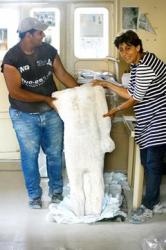
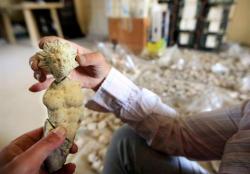 Sidon - A statue of a Phoenician priest has been uncovered at an excavation site in the southern city of Sidon, along with other antiquities, the most unique find for Lebanon in decades, the British Museum team announced Monday. The priest, 115 centimeters high and dating back to the sixth century B.C., was found at the Freres College site, which has been under excavation for the last 16 years, the head of the excavation, Claude Doumit Serhal, announced at a press conference at the Lebanese Directorate General of Antiquities. “Nothing comparable has been found in Lebanon since the early 1960s, and only three other examples originating from Sidon, Umm al-Ahmed and Tyre are housed in the Beirut National Museum,” the statement said. The figurine is that of a male wearing a pleated kilt, known as “shenti,” with a pendant flap from the waist to the kilt’s hem. The left hand is in a closed fist and holding an unknown object, “probably a scroll or a handkerchief,” according to the statement. Archeologists found the statue lying on its front, as it was re-used by the Romans and placed under a marble pavement in that position. Three new rooms were also found in a third millennium B.C. public building, along with a 200-kilogram deposit of charred wheat called einkorn, 160 kilograms of broad bean and 20 burials belonging to both adults and infants from the second millennium B.C. This year’s excavation has been extended over six months, having started in January, in order to prepare for the building of an on-site museum, the statement added.
Sidon - A statue of a Phoenician priest has been uncovered at an excavation site in the southern city of Sidon, along with other antiquities, the most unique find for Lebanon in decades, the British Museum team announced Monday. The priest, 115 centimeters high and dating back to the sixth century B.C., was found at the Freres College site, which has been under excavation for the last 16 years, the head of the excavation, Claude Doumit Serhal, announced at a press conference at the Lebanese Directorate General of Antiquities. “Nothing comparable has been found in Lebanon since the early 1960s, and only three other examples originating from Sidon, Umm al-Ahmed and Tyre are housed in the Beirut National Museum,” the statement said. The figurine is that of a male wearing a pleated kilt, known as “shenti,” with a pendant flap from the waist to the kilt’s hem. The left hand is in a closed fist and holding an unknown object, “probably a scroll or a handkerchief,” according to the statement. Archeologists found the statue lying on its front, as it was re-used by the Romans and placed under a marble pavement in that position. Three new rooms were also found in a third millennium B.C. public building, along with a 200-kilogram deposit of charred wheat called einkorn, 160 kilograms of broad bean and 20 burials belonging to both adults and infants from the second millennium B.C. This year’s excavation has been extended over six months, having started in January, in order to prepare for the building of an on-site museum, the statement added.
http://www.dailystar.com.lb/News/Lebanon-News/2014/May-19/257031-unique-statue-of-phoenician-priest-discovered-in-sidon.ashx#axzz32MymuZBd
INDE – 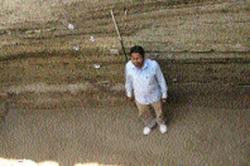 Tarighat - Remnants of a burnt ancient city, believed to be dating back to 2nd century BC, have been found in an archaeological site in Tarighat, nearly 30 km from here. The “gutted settlement” reminds one the famed Roman city of Pompeii that got buried under 13-20 feet of ash and pumice in the eruption of Mount Vesuvius in 79 AD. The remains of the charred city have been found around 20 feet below Tarighat archaeological site which came into national focus when excavation had brought to surface a 2,500-year-old urban centre in 2013. “It is a stunning discovery. Our excavation, which began last year, has reached 35 feet deep now. The excavation has so far yielded remains of various settlements that had come up at the site from sixth century AD to second century BC. A huge burnt patch of around eight feet high was unearthed at 9-12th layer believed to be dating back to second century BC,” Tarighat excavation director and archaeologist J.R. Bhagat told this newspaper here on Thursday. According to him, evidence establishing that the settlement was completely devastated by a huge fire have been found at the site. The peculiar features, pointing to devastation by fire, have been noticed inside all trenches dug up in the site at the same level. These types of burnt patches are also visible in the sections of the mound which was washed away by flood in river Kharoun. The archaeological site is situated on the bank of river Kharoun. “In all the trenches at this level long patches of burnt walls, floors, charcoal remains of bamboo, brickbats, pottery, bones and postholes have been found. This indicates that a thriving urban centre had come up there in second century BC which was completely destroyed by fire,” he revealed.
Tarighat - Remnants of a burnt ancient city, believed to be dating back to 2nd century BC, have been found in an archaeological site in Tarighat, nearly 30 km from here. The “gutted settlement” reminds one the famed Roman city of Pompeii that got buried under 13-20 feet of ash and pumice in the eruption of Mount Vesuvius in 79 AD. The remains of the charred city have been found around 20 feet below Tarighat archaeological site which came into national focus when excavation had brought to surface a 2,500-year-old urban centre in 2013. “It is a stunning discovery. Our excavation, which began last year, has reached 35 feet deep now. The excavation has so far yielded remains of various settlements that had come up at the site from sixth century AD to second century BC. A huge burnt patch of around eight feet high was unearthed at 9-12th layer believed to be dating back to second century BC,” Tarighat excavation director and archaeologist J.R. Bhagat told this newspaper here on Thursday. According to him, evidence establishing that the settlement was completely devastated by a huge fire have been found at the site. The peculiar features, pointing to devastation by fire, have been noticed inside all trenches dug up in the site at the same level. These types of burnt patches are also visible in the sections of the mound which was washed away by flood in river Kharoun. The archaeological site is situated on the bank of river Kharoun. “In all the trenches at this level long patches of burnt walls, floors, charcoal remains of bamboo, brickbats, pottery, bones and postholes have been found. This indicates that a thriving urban centre had come up there in second century BC which was completely destroyed by fire,” he revealed.
http://www.asianage.com/india/remains-burnt-ancient-city-found-chandigarh-594
ROYAUME UNI – 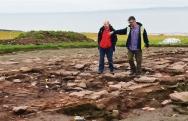 Maryport - Maryport is emerging as an important part of the Roman Empire long before Hadrian's Wall was built, the latest archaeological dig at Camp Farm is indicating.Artefacts found this year include fragments of tableware imported from Gaul and the Rhineland, storage vessels that once contained Spanish olive oil and Gallic wines, fragments of fine glass vessels and several items of jewellery, including a jet finger-ring and part of a decorated glass bangle. The remains of a stone building have been removed, revealing earlier Roman remains beneath. The stone structure replaced an earlier long, narrow building made entirely from timber. One pit has yielded a Samian ware cup in a style that had fallen out of fashion by the early years of the second century AD. The find, with a late first century Samian vessel that was recovered last year, could mean that the settlement was occupied before the reign of the emperor Hadrian (AD 117-38) and again suggests that there was an earlier Roman fort at Maryport.
Maryport - Maryport is emerging as an important part of the Roman Empire long before Hadrian's Wall was built, the latest archaeological dig at Camp Farm is indicating.Artefacts found this year include fragments of tableware imported from Gaul and the Rhineland, storage vessels that once contained Spanish olive oil and Gallic wines, fragments of fine glass vessels and several items of jewellery, including a jet finger-ring and part of a decorated glass bangle. The remains of a stone building have been removed, revealing earlier Roman remains beneath. The stone structure replaced an earlier long, narrow building made entirely from timber. One pit has yielded a Samian ware cup in a style that had fallen out of fashion by the early years of the second century AD. The find, with a late first century Samian vessel that was recovered last year, could mean that the settlement was occupied before the reign of the emperor Hadrian (AD 117-38) and again suggests that there was an earlier Roman fort at Maryport.
http://www.timesandstar.co.uk/news/people/maryport-s-status-in-roman-empire-keeps-on-increasing-1.1138025
ROYAUME UNI – 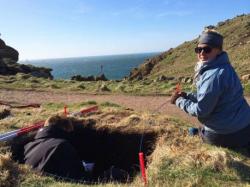 Land's End -A day of digging by three expert archaeologists has unearthed more than 60 objects from a one-metre square excavation at Land’s End. In February the wild rabbits at Land’s End accidentally uncovered a collection of flint scrapers and arrowheads while burrowing their warrens. This discovery prompted Land’s End to commission a thorough archaeological investigation of their land and now the finds discovered and compiled by Big Heritage UK have revealed some further startling results. Evidence of an iron-age hill fort, a bronze-age barrow cemetery, a Neolithic passage grave and more, all compiled in the report, has been further compounded by a plethora of ancient objects unearthed in the course of a one day dig at the British landmark. The Big Heritage team have now found Mesolithic stone hammers, arrow heads, scrapers and waste from a flint tool-making factory during their preliminary one-day excavation at the site. Dean Paton, lead archaeologist for Big Heritage, said: “We discovered more prehistoric tools in just one square metre of Land’s End than in countless other sites combined. We've found about 60 flint tools and two stone hammers and they are stunningly beautiful.
Land's End -A day of digging by three expert archaeologists has unearthed more than 60 objects from a one-metre square excavation at Land’s End. In February the wild rabbits at Land’s End accidentally uncovered a collection of flint scrapers and arrowheads while burrowing their warrens. This discovery prompted Land’s End to commission a thorough archaeological investigation of their land and now the finds discovered and compiled by Big Heritage UK have revealed some further startling results. Evidence of an iron-age hill fort, a bronze-age barrow cemetery, a Neolithic passage grave and more, all compiled in the report, has been further compounded by a plethora of ancient objects unearthed in the course of a one day dig at the British landmark. The Big Heritage team have now found Mesolithic stone hammers, arrow heads, scrapers and waste from a flint tool-making factory during their preliminary one-day excavation at the site. Dean Paton, lead archaeologist for Big Heritage, said: “We discovered more prehistoric tools in just one square metre of Land’s End than in countless other sites combined. We've found about 60 flint tools and two stone hammers and they are stunningly beautiful.
http://www.falmouthpacket.co.uk/news/11233280._Indiana_Jones__discovery_at_Land_s_End_archaeology_dig/
USA –  Hampton - Archaeologists began peeling back the earth a few hundred yards from the center of this historic old Virginia port town Wednesday, searching for signs of the pioneering freedmen's village where thousands of refugee slaves lived during the Civil War. Using the smoothfaced shovel of a Gradall excavator, they dug down through almost two feet of soil piled up over more than 150 years, looking intently for any stain or artifact that might provide a link to the densely built settlement of shanties that rose up in the scorched ruins of Hampton after a Confederate-set fire destroyed it in August 1861.But even after several promising postholes and a scattering of mid-1800s artifacts emerged from the dirt early Thursday, archaeologist Nicholas M. Luccketti tempered his optimism with the recognition that finding any significant trace of the contraband slaves' short-lived and impermanent cluster of small dwellings, fenced-in lots and meandering alleyways will require both luck and determination.We're finding what looks like the sort of features we anticipated from studying the Civil War photographs of the contraband camp. We have artifacts from the right period showing up on the surface. So we're cautiously optimistic," he said Thursday. "But the structures we see in the pictures were slightly built and ephemeral. They were followed by continuous occupation and many more buildings constructed on top of them from the Civil War period on. So this is going to be an extraordinary challenge."
Hampton - Archaeologists began peeling back the earth a few hundred yards from the center of this historic old Virginia port town Wednesday, searching for signs of the pioneering freedmen's village where thousands of refugee slaves lived during the Civil War. Using the smoothfaced shovel of a Gradall excavator, they dug down through almost two feet of soil piled up over more than 150 years, looking intently for any stain or artifact that might provide a link to the densely built settlement of shanties that rose up in the scorched ruins of Hampton after a Confederate-set fire destroyed it in August 1861.But even after several promising postholes and a scattering of mid-1800s artifacts emerged from the dirt early Thursday, archaeologist Nicholas M. Luccketti tempered his optimism with the recognition that finding any significant trace of the contraband slaves' short-lived and impermanent cluster of small dwellings, fenced-in lots and meandering alleyways will require both luck and determination.We're finding what looks like the sort of features we anticipated from studying the Civil War photographs of the contraband camp. We have artifacts from the right period showing up on the surface. So we're cautiously optimistic," he said Thursday. "But the structures we see in the pictures were slightly built and ephemeral. They were followed by continuous occupation and many more buildings constructed on top of them from the Civil War period on. So this is going to be an extraordinary challenge."
http://www.dailypress.com/features/history/our-story/dp-archaeologists-probe-for-civil-war-hamptons-pioneering-refugee-slave-camp-20140522,0,6037489.post
INDE –  Nizamuddin - When Emperor Akbar’s trusted lieutenant and reputed scholar Abdur Rahim Khan commissioned the construction of a red sandstone tomb near the Hazrat Nizamuddin Basti in memory of his wife, he probably had no inkling that 400 years later, the tomb would become a refuge for love birds, dedicated junkies and stray dogs. The tomb, built as a labour of love, has now been reduced to a crumbling edifice with visible cracks all over the structure. However, this does not diminish the Khan-e-Khanan’s significance in terms of its aesthetic beauty. It is a testament to the immense contribution of the Mughals to enrich the country’s cultural heritage.
Nizamuddin - When Emperor Akbar’s trusted lieutenant and reputed scholar Abdur Rahim Khan commissioned the construction of a red sandstone tomb near the Hazrat Nizamuddin Basti in memory of his wife, he probably had no inkling that 400 years later, the tomb would become a refuge for love birds, dedicated junkies and stray dogs. The tomb, built as a labour of love, has now been reduced to a crumbling edifice with visible cracks all over the structure. However, this does not diminish the Khan-e-Khanan’s significance in terms of its aesthetic beauty. It is a testament to the immense contribution of the Mughals to enrich the country’s cultural heritage.
http://www.thehindu.com/features/metroplus/tomb-of-neglect/article6040674.ece?utm_source=RSS_Feed&utm_medium=RSS&utm_campaign=RSS_Syndication
ROYAUME UNI – 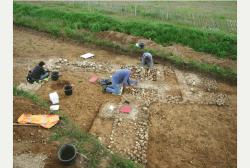 Fetcham - A Stone Age hunting camp and a Roman villa were among several prehistoric finds dating back 10,000 years discovered during the laying of a new water main in Fetcham. The finds were unearthed during the installation of a new iron pipeline by Sutton and East Surrey Water at Cobham Road in the valley near the River Mole. "The Fetcham excavation has been quite surprising, however, and we didn't expect findings from 10,000 years ago to come to light. We're excited to have been a part of it." Neolithic, Bronze Age and Iron Age finds were made, but the earliest discoveries were of a Late Upper Palaeolithic or Early Mesolithic Stone Age camp where hunter-gatherers had stopped to knap flint and make or repair hunting equipment. "This type of evidence is extremely rare, with few parallels regionally, or even nationally," added Rob Poulton, senior archaeological adviser at the site. "The flintwork found ties in with the theory that hunter-gatherers moved along terraces and flood plains of the rivers, utilising naturally exposed outcrops of flint."The site would have provided an area with access to water, waterfowl, game and shelter. The remains of a Roman building, consisting of flint wall foundations was also identified, with relatively large amounts of flue tile suggesting the existence of a bathhouse complex. Pottery found indicates its period of use began in the middle of the second century and extended into the fourth century. Mr Poulton added: "Finding a Roman villa close to a river is very unusual in Surrey and the discovery is an important addition to our knowledge."
Fetcham - A Stone Age hunting camp and a Roman villa were among several prehistoric finds dating back 10,000 years discovered during the laying of a new water main in Fetcham. The finds were unearthed during the installation of a new iron pipeline by Sutton and East Surrey Water at Cobham Road in the valley near the River Mole. "The Fetcham excavation has been quite surprising, however, and we didn't expect findings from 10,000 years ago to come to light. We're excited to have been a part of it." Neolithic, Bronze Age and Iron Age finds were made, but the earliest discoveries were of a Late Upper Palaeolithic or Early Mesolithic Stone Age camp where hunter-gatherers had stopped to knap flint and make or repair hunting equipment. "This type of evidence is extremely rare, with few parallels regionally, or even nationally," added Rob Poulton, senior archaeological adviser at the site. "The flintwork found ties in with the theory that hunter-gatherers moved along terraces and flood plains of the rivers, utilising naturally exposed outcrops of flint."The site would have provided an area with access to water, waterfowl, game and shelter. The remains of a Roman building, consisting of flint wall foundations was also identified, with relatively large amounts of flue tile suggesting the existence of a bathhouse complex. Pottery found indicates its period of use began in the middle of the second century and extended into the fourth century. Mr Poulton added: "Finding a Roman villa close to a river is very unusual in Surrey and the discovery is an important addition to our knowledge."
http://www.dorkingandleatherheadadvertiser.co.uk/Stone-Age-relics-dating-10-000-years-waterworks/story-21125035-detail/story.html?